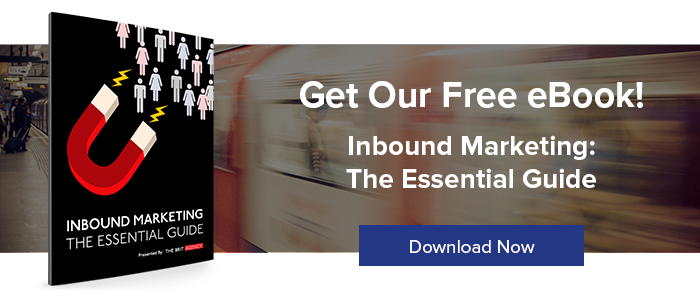There are some amazing benefits to publishing a frequent website B2B blog for your company, and as blogging is an important component of your Inbound Marketing program, it's critical to make sure blogging works hard for you.
B2B Businesses that maintain a blog that is frequently published, have 55% more website visitors, 97% more Inbound links, and five times more indexed pages than businesses that don't (Source: HubSpot Annual Inbound Marketing Survey 2016).
If you have a B2B blog, and you're using it to generate more awareness and interest about your business - well done! you're going to attract new website visitors and leads.
You probably know already what it takes to be extra successful at blogging - the blog title and content has to resonate with a persona defined target audience, and you have to offer something informative, fun and interesting to read. In order to take your blogging to the next level, business blogs have to be designed for the best performance possible.
So what can you do to improve the performance of your blog and get it noticed even more? We recommend following these five blog performance enhancement and optimization tips.
1. Share Your Blog Across Social Media
After publishing your blog post, you must share it across all your social media accounts, LinkedIn, Facebook, Twitter and Google Plus, and then do your best to get other people (employees, influencers and stakeholders) to like and share your blog on their favourite social media platforms. This is a simple, yet highly effective routine that should be regarded as mandatory for your organization, and standard practice for everyone in your company; just let them know when the blog is posted and ask them to like and share. Not everyone in your social network regularly visits your website, so this is one of the best ways to start attracting them to revisit your website, via an interesting blog post.
Once visitors have read your blog headline, or quick intro statement on social media, they may want to share it with their respective social media networks, so make it easy for everyone. Add "Share" and "Like" buttons to each blog post for every relevant social media channel you can think of.
Also, include an RSS feed, which makes it easier to publish on social media and syndicate your blog, which can expand your potential audience even further. Perhaps one day your blog will be hot enough to go viral on its own, but until then you have to nudge it forward each time.
2. Create Blog Titles That are Keyword-Rich, Interesting and Easily Findable
Keywords that appeal to your persona are critical to the success of your blog. Keywords should appear in your blog title and throughout your blog, including the first paragraph, headlines, and sub headlines.
Use a reliable keyword analyser to research keywords and choose the best ones for your title. But don't stop with the keywords; make your entire title a favorite search term, or a question that you buyer persona will ask. Think about what kind of phrase your readers might put into a search query, and make that your title. Even if other blogs are using it, your blog's ranking will go up, especially if you've optimized the rest of your content.
An optimized blog title is crucial to making the search engines - and potential readers - notice your blog. If your blog title is unique, then you should be able to get that title ranked #1 in Google without any problem - and that's where the power of blogging lies - being found by the search engines and getting a top three page ranking is what blogging is all about.
3. Add Video Content to Your Blog
We know that this is a tough one for many B2B businesses to pull off - especially when there are limited resources available, and any form of video production and editing sounds impossible to do. However, more and more research is showing that visual content, especially video, is viewed and shared more often than text-based content.
Of course, the content should be relevant to your topic, interesting to your target persona, and contain content keywords, just like your blog.
If you're talking about a new product, write about it and then embed an instructional video that shows viewers how to use it - they'll love it - If you're writing about recent industry trends, reformat your ideas into a colorful infographic.
4. Link Your Blog to Other Blog Posts and Other Website Content
Ideally, your blog posts are about 'evergreen' topics. This is the type of content that will never go out of fashion.
Therefore, always write blog content that will not become dated. A B2B blogger can choose from a wide range of timeless topics, but new or occasional readers who read one post won't automatically know about previous posts on similar topics. Linking to your own content might seem odd, but it boosts overall blog traffic and is excellent for developing topic clusters and SEO. Linking your latest blog to other publications is of course okay, but also link it to one of your older blogs. Just make sure the material is still relevant; you don't want to be accused of keeping outdated content on your blog.
5. Keep Your Blog Alive by Posting New Blog Content as Frequently as Possible
This is where blogging can be a powerful tool for Inbound Marketing. If you only update your blog once a month, or so, your regular readers may get bored and move on to other blogs. If you update your blog more frequently, though, you might not lose them at all.
Publish a new blog at least once a week; if you can do it more often, good for you, as long as you don't sacrifice quality for quantity. Publishing low-quality content may backfire, so if you're stuck for ideas do some research into what your potential audiences are looking for.
The number of B2B blogs has exploded in recent years, so keep your quality up, and always boost the performance of your blog by optimizing it for maximum effect.
THE BRIT AGENCY is a B2B Inbound Marketing Agency providing Inbound Marketing, Inbound Website Design and Inbound Sales services to companies around the world. We're focused on growing website traffic, qualified leads and sales, using the Inbound lead generation and marketing automation process.
THE BRIT AGENCY is a certified Gold Tier Hubspot Partner, a HubSpot COS certified Inbound Website Design Agency, a Shopify eCommerce Partner, and a certified "Google Badged Agency Partner". We have offices in Toronto and Barrie, Canada, and Salisbury, UK.


